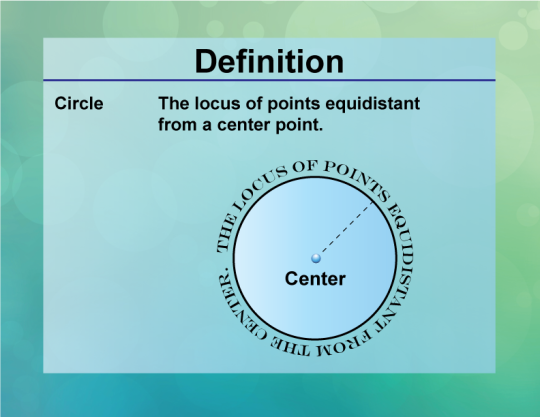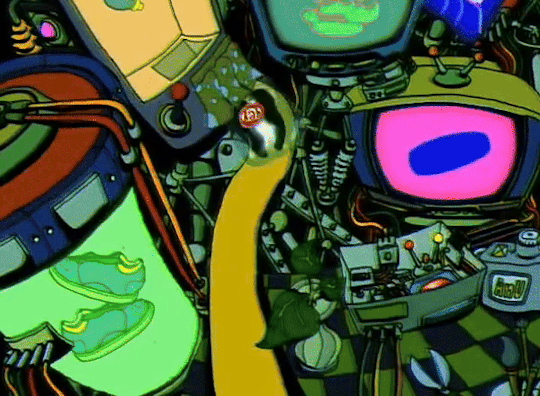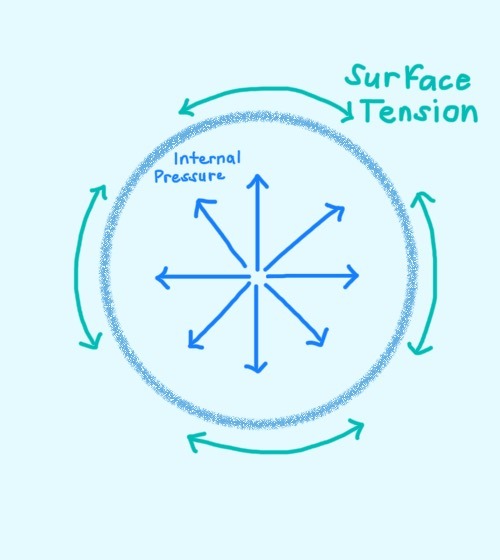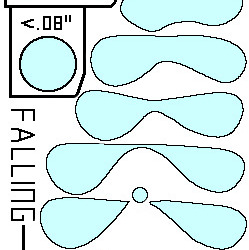#sciencenature
Explore tagged Tumblr posts
Text

K.O
#artwork#my draws#art#artoftheday#drawing#artists on tumblr#art commisions#dark academia#dark aesthetic#dark art#the dark knight#aesthetic#aespa#aestethic#insp#colours#angel tag#dreamcore#weirdcore#webcore#tumblr girls#cute#woman#illustration#my gifs#gif#animation#laboratory#sciencenature#electricity
29 notes
·
View notes
Text
How Rainbows Form pt. 2
To add to a previous post, this one explains how rainbows appear to us as half-circles!
Ok, so other than the dispersion of light in raindrops, another factor in the occurrence of rainbows is seeing them. We do not see every individual rainbow formed from each droplet because we’re too far away to see them. Instead, we see different individual colors from different raindrops based on their height and angle from us.

A raindrop at a 42-degree angle from us relative to the sun would reflect red light to us and end up looking red. The other raindrops below it would look orange, yellow, green, blue, and indigo in the angles between 40 and 42 degrees. Violet would be below the other colors at a 40-degree angle from us and the sun.
This would also explain why we see rainbows as an arc or half-circle. According to Wikipedia, “A circle is a shape consisting of all points in a plane that are at a given distance from a given point, the center”.

The sun shines light on many points at once from its direction. For an observer to be able to see colors from a rainbow, the dispersed light reflected from the sun would have to reach them from an angle. This means that all the other raindrops reflecting colors to the observer would also have to reach their eyes at 40-42 degree angles, which also leads to all the points (in this case, raindrops showing color) being at similar distances away from the observer.
To make this easier to understand, I tried to use a triangle ruler where the lines (base and hypotenuse) represented the path of the light from the sun to the observer’s eyes; the point of the triangle touching the ground would represent the observer.

If the triangle was tilted so that the point on the bottom stayed in its place, it would go in the direction of an arc. If all the points on this arc were mapped out, it would form a half-circle or at least part of one.

It would form a full circle if no ground or horizon were blocking the triangle ruler. This is the same for rainbows. Rainbows are full circles, but the lower half is usually blocked by the ground or horizon. This is also the reason why people on airplanes or in the sky can sometimes see rainbows as circles because the horizon does not block them.
Rainbows are also similar to mirages since they’re a result of the behavior of light, so unfortunately you can’t ride them or find any gold at the end. Additionally, the rainbow will move with you because only certain raindrops can form the rainbow you see depending on your position and location; Buttttt! this also means that everyone sees a different rainbow, which makes each rainbow as unique as the observers who look at one :) even though it may not look that way at first glance
I’m gonna stop writing about rainbows now but I hope this and the other post were good explanations for the formation of rainbows!
#physics#science#stem#information#info post#infodump#rainbow#rambles#raindrops#sunlight#hyperfixation#natural phenomena#sciencenature#scientific illustration#optics#light#nature#phenomenon#science diagram#diagram#drawing#bad drawing#reflection#refraction#ramblings#perspective#education#edited photos
7 notes
·
View notes
Text
entry 03
do not be afraid to use technology if using paper based methods of note taking, planning and scheduling and journaling.
when i first started my research project i was afraid of using only applications and software such as Notion, drives for storage, Microsoft Word AI grammar assistance etc. I was afraid because i was told (and anxious about it myself) that i could lose my data and information if i didn't have a backup on paper.
this resulted in me not quite meeting my weekly deadlines with tasks and goals because i was spending time "backing up" all my data, planning, schedules, meeting notes, everything.
Whilst i definitely agree with others that you should have a back up, a lot of these applications and software are so well developed and have really well functioning servers, there is such a minimal chance of just losing everything. it would be more logical to make back ups on other storage platforms/drives than keeping everything in paper AS WELL. this is so time consuming and sends you in a panic every time you need to upload data, write notes, prepare documents, edit documents, review data and leaves you with notes you made hastily (and anxiously) which often times never even helped me as the notes were illegible because i was in such a rush.
of course, a paper based method for laboratory notes is a good idea as devices are not recommended in the labs if you're working with biological matter/chemical substances - pencil down your notes and then you can go home if you have the time and the need to write it onto a notion page or type up a document so that you can review the protocol and how you performed during and the outcomes, any changes you may need to make etc.
you can use notion for your research scheduling and planning and just keep a very simple bullet journal/notebook for day to day notations and planning. i had been told to make sure i have a paper based record of everything i wrote on my notion but i think you can keep an abbreviated version and rather keep a copy pasted document of this and/or screenshots and store that across multiple drives (or one if you're not an anxious academic like me, haha).
if anyone tells you how you should do something so intricately personal to each student/researcher because they do not like the interface you use (yes, i was told i should not use the one thing that has worked for me because it was too difficult for the other party to understand or review), it is obviously nice and kind to try and provide things a format they understand, but do not stop doing the thing you enjoy and that actually helps you reach your goals.
context for number 3:
i found notion through various content creators in the research realm, with mixed recommendations ranging from yes it works well to no not for me. i struggle with planning and procrastinating and academic challenges so i decided to give it a go. honestly, the fact that it was aesthetically customisable was a big plus. that is just simply something that makes me want to work. the next thing was its cross compatibility with other apps and software i used, primarily google. it helped me keep track of upcoming meetings, events and urgent tasks and provided a way for me to visually see my progress. but someone i was wokring with, whose opinion mattered very much to me, had mentioned that they were not a fan and that they did not have the time to use the interface, even though the interface was not our primary mode of communication regarding my research project, it was simply a way for them to see how i was spending my time or planning to as a student of theirs. needless to say, i gave up because their way took way too much time already. it is not a problem or a topic that requires someone to blame, i just was in the midst of an already overwhelming time in my project and had to just do what i needed to survive (lol).
anyways, the lesson i learnt was, after falling a couple months behind because of poor planning and compatibility with how i was going about my most important component of my research was that you really need to prioritise the thing that works for you. whether that is paper based or digital.
but you cannot spend every moment fearing that notion will drop off the face of the earth with all your notes and plans along with it. i wasted so much time stressing and creating paper and digital back ups of EVERYTHING. i have now had to spend essentially a month organising things across multiple emails and drives just to get a start on my next big project. the most important lesson will definitely be that you need to train and teach yourself to know what are things that require a back...
you do not need 17 backups, paper and digital of plans passed and plans to come, you will quickly be reminded or be able to recall most such things as they will stress you out and haunt you so much anyways.
however you certainly do need a sufficient back up of data that belongs to the university as part of your project, or any personal methods of tracking such things.
anyways, sorry for the long rambles i post, i am using tumblr as a way to have a blog until i can actually get a website and publish better and more concise posts. i hope you still enjoy reading or at least find some solace or advice in between it all!
#academia#post grad problems#post grad advice#researchers#stem academia#university#academics#scientific research#science#sciencenature#marine biology#marine research#marine biology research#biology#biology research#notion#studyblr community#studying#studyblr#academic
8 notes
·
View notes
Text
look, im never gonna admit to being good at science, I just like plants and shit. but every time I am in a lab and the head scientists or whatever is explaining something, the amount of pure joy I get from staring them dead in the eye and asking "can I eat it?" and watching them struggle and come to terms with the fact that they might have to physically restrain me from eating god knows what in that lab is immeasurable.
#god I love being a menace to smart people#never leave me unsupervised and hungry#science#plants#shitpost#laboratory#chemicals#sciencenature
5 notes
·
View notes
Text
Enzimas
As enzimas são catalizadores, ou seja, aceleram uma reação, no entanto faz-se de suma importância ressaltar que as mesmas não têm a capacidade de modificar o equilíbrio químico. As enzimas precisam de temperatura e pH ideal para atuar, pois a maioria delas são proteínas, exceto pelas ribozimas advindas do RNA. As enzimas são altamente especializadas, ou seja, para que elas atuem é preciso que elas tenham afinidade (KM) com o substrato, portanto existem diferentes famílias de enzimas que serão listadas em outro post. As enzimas são catalizadores, portanto não se destroem, e sim reciclam-se, isso porquê é muito mais econômico para o corpo em termos de gasto de energia evitar o ato de fabricar enzimas a todo momento. Mas como são proteínas em sua maioria, não esquecendo-se das ribozimas um caso especial, é possível que se desnaturem, dissociem em subunidades ou degradarem-se dependendo da variação de pH ou temperatura, por exemplo.
A: Celiny Arguilera
Estudante de ciências biológicas.
9 notes
·
View notes
Text
Complete Stack Developer Course with Placement Guarantee to Unlock Your Career Potential
Are you aspiring to become a Full Stack Developer and looking for a comprehensive course that not only hones your skills but also guarantees job placement? The field of Full Stack Development is thriving, and skilled professionals are in high demand across industries. In this article, we'll delve into the concept of a Full Stack Developer course with a placement guarantee and how it can be a game-changer for your career aspirations.
The Demand for Full Stack Developers
Full Stack Developers are versatile professionals who have expertise in both front-end and back-end web development. They are proficient in a wide range of programming languages, frameworks, and tools necessary to build and deploy complex web applications. Companies value Full Stack Developers for their ability to work across the entire development stack, from designing user interfaces to managing databases and server-side logic.
Importance of a Placement Guarantee
While acquiring technical skills is crucial, securing a job after completing a Full Stack Developer course is equally important. A course with a placement guarantee provides assurance to students that they will have opportunities to showcase their skills and land a job in the industry. It indicates that the course provider is confident in the quality of their training and the market demand for Full Stack Developers.
Features of a Full Stack Developer Course with Placement Guarantee
1. Comprehensive Curriculum:
These courses cover a wide array of technologies and concepts essential for Full Stack Development. This includes front-end technologies like HTML, CSS, JavaScript, popular frameworks like React or Angular, back-end technologies such as Node.js, Python with Django, databases like MySQL or MongoDB, version control systems, and deployment strategies.
2. Hands-On Projects:
Practical experience is key to mastering Full Stack Development. A good course includes hands-on projects, case studies, and real-world applications to apply theoretical knowledge to practical scenarios.
3. Industry-Relevant Skills:
The curriculum is designed in collaboration with industry experts to ensure that students learn the skills and technologies that are in demand in the job market.
4. Internship Opportunities:
Some courses offer internship programs or collaborations with companies, providing students with valuable industry exposure and practical experience.
5. Career Services:
Apart from training, these courses often provide career support services such as resume building, interview preparation, and networking opportunities with potential employers.
Advantages of Enrolling in a Course with Placement Guarantee
- Increased Confidence:
Knowing that you have a job placement guarantee can boost your confidence during the learning process.
- Focused Learning:
You can concentrate on learning and honing your skills without worrying excessively about job hunting post-course completion.
- Professional Growth:
Landing a job through a placement program kick-starts your professional journey and opens doors to further career growth and opportunities.
Conclusion
A Full Stack Developer course with a placement guarantee can be a stepping stone towards a successful and rewarding career in the tech industry. It combines comprehensive training with the assurance of job placement, giving you the confidence and skills needed to excel as a Full Stack Developer. Research different course providers, compare their offerings, and choose a program that aligns with your career goals and aspirations. With dedication, continuous learning, and the right guidance, you can unlock your full potential and thrive in the dynamic field of Full Stack Development.
Readmore:#FullStackDevelopmentInPune , #FullStackclassesinPune ,
#FullStackcourseinPune ,
#fullstack,
#fullstacktraininginpune
#fullstack#full stack developers in pune#full stock#sciencenature#full stack course#full stack developer#full stack training#full stack web development#full stack software developer
0 notes
Text
Jeiotech Lab Equipments - Chemstock UAE
🔬 Level Up Your Lab with Jeiotech Equipment: Now Available at Chemstock!
Attention researchers and lab professionals in the UAE! 🚀 Chemstock is thrilled to announce our exclusive distributorship of Jeiotech laboratory equipment.

💡 Jeiotech offers a comprehensive range of high-quality instruments, including:
Ovens
Incubated Shakers
Magnetic Stirrers & Mixers
Chillers & Circulators
Incubators
Water Baths
Orbital Shakers
Autoclaves
By partnering with Chemstock, you gain access to:
The latest Jeiotech lab equipment: Stay at the forefront of scientific advancements with cutting-edge technology.
Unparalleled selection: Find the perfect instrument for your specific research needs.
Unwavering reliability: Trust Jeiotech's reputation for quality and performance.
Exceptional customer support: Our team is here to assist you throughout the entire process.
🔍 Elevate your laboratory capabilities today! Contact Chemstock to explore the extensive range of Jeiotech equipment and find the ideal instruments to propel your research forward.
👨💼 Contact Person: Shahul hameed
📧 Email: [email protected]
🌐 Website: https://chemstock.ae/
📞 Mobile: +971 54 582 5093
📲Whatsapp: https://wa.link/mtv38c
#Jeiotech #LabEquipment #ScientificInstruments #Chemstock #ExclusiveDistributor #UAELabs #LabRevolution #ScientificBreakthroughs #LabEssentials #QualityScience #FutureProofLab #UAEResearchers #LabScientists #BiotechUAE #LifeScienceUAE #ChemistsUAE #DubaiScience #JeiotechLabs #LaboratoryAutomation #ScienceCommunity #ScientificNetwork #dubai #uae #abudhabi
Discover more at Chemstock today!
#chemical#chemicaldistribution#chemicals#chemstock#laboratory#organic chemicals#research chemicals#uae#equipment#lab#sciencenature
0 notes
Text

Electronics Batteries, Chargers & Accessories
#electronics#computing#laptops#technology#computer#brand#batteries#battery#sciencenature#electricity#materials#solutions#la chargers#Chargers
0 notes
Text



Sorry for the blurry image, I hope it clears out!
1 note
·
View note
Text
A hundred years from now, Sir David Attenborough’s body may have turned to dust, but a fossilised sea creature, thought to represent Earth’s earliest animal predator, will continue to bear his name.
Discovered in Charnwood Forest, Leicestershire, where Attenborough hunted for fossils as a child, the creature predates what was previously thought to be the oldest predator by 20m years.
Palaeontologists have named it Auroralumina attenboroughii, in honour of the TV presenter. The first part of its name is Latin for dawn lantern, in recognition of its great age and resemblance to a burning torch, and the creature is thought to have used a set of densely packed tentacles to capture food in Earth’s early oceans.
#fossils#explore#dinos#dinosaurs#time#prehistoric#science#david attenborough#life#earth#discovered#sciencenature#science daily#latest science news sciencedaily
32 notes
·
View notes
Text
IT IS SCIENTIFICALLY POSSIBLE TO DIE FROM DRINKING TOO MUCH WATER
IT'S IMPORTANT TO STAY HYDRATED TO KEEP OUR BODIES FUNCTIONING WELL. HOWEVER, TOO MUCH WATER CAN ALSO BE FATAL. WHEN A DEHYDRATED PERSON DRINKS TOO MUCH WATER WITHOUT THE ACCOMPANYING ELECTROLYTES, THEY CAN DIE FROM WATER INTOXICATION AND HYPONATREMIA.
#science#sciencenature#sciencenews#scientists#scientific#tumblrposts#tumblrdaily#factoftheday#knowledge#information#laboratory experiments#medical experiments#water#learnsomethingnew#facts#informatology
14 notes
·
View notes
Text

Lab
#artwork#my draws#art#artoftheday#drawing#artists on tumblr#art commisions#dark academia#dark aesthetic#dark art#the dark knight#aesthetic#aespa#aestethic#insp#colours#angel tag#dreamcore#weirdcore#webcore#tumblr girls#cute#woman#illustration#my gifs#gif#animation#laboratory#sciencenature#electricity
27 notes
·
View notes
Text
How Rainbows Form
So for the past few years, I’ve been disappointed with the lack of occurrence of rainbows in my area. Maybe it’s because the weather has been more extreme lately, resulting in more storms and heat waves here in the tropics than in previous years. (Perhaps it is my fault for going outside less, but I have my reasons)
So anyway, I decided to do some research on the formation of rainbows and it turns out that there are a lot of processes and science behind rainbows forming. So how are rainbows formed:
Conditions for Rainbows to Form
There are a few conditions that need to be met before rainbows can be seen:
The sun needs to be lower in the sky (which is in the early morning or late afternoon) and behind the observer
The source of water droplets (in this case, rain) should be in front of the viewer; the rainbow will show up there, opposite to the direction of the sun

Note that the shape of raindrops falling in the air is more circular than tear-shaped (my drawing isn’t good at showing this so sorry). For a small raindrop in space, the surface tension of water vs its internal pressure pushing outwards on all sides makes the water droplets spherical.

Air resistance drags less on falling raindrops than on solid surfaces, so in the air, we don’t get as much of a tail on the water droplets as we would normally get from water droplets on windows. It will go against them as they fall in the air, which can cause an elliptical/curved dome shape for bigger droplets, but it’s usually not enough to cause the popular teardrop shape.

source: https://gpm.nasa.gov/education/articles/shape-of-a-raindrop
How rainbows are formed
Rainbows are formed from reflection and refraction occurring in many water droplets at once. This process starts when white light from the sun enters the raindrops. When waves reach the boundary between two media, some or all of the waves get reflected

However, in our case, the water droplet is not as rigid as mirrors or metal so only some of the light gets reflected.
For the explanations below, I have drawn a model of a raindrop to help show the process of refraction and reflection in water droplets:

A) The rest of the light enters the water and refracts. White light is made of all colors in the color spectrum. All the different frequencies of white light, the colors, travel at different speeds in transparent materials like prisms (or in this case, the raindrop). So the colors refract differently and bend at different angles, with red bending the least and violet bending the most. This is how the white light gets dispersed into a rainbow
B) The now dispersed light hits the other end of the raindrop, and reflects again, flipping the rainbow and diffracting the light even more. (Some of the light exits and never returns of course)
C) The light leaves the water droplet as a spectrum of colors! It was dispersed even more since it experienced refraction and diffraction again from going through the boundary between water and air.
In the poorly made drawing, the angle between the sunlight and the exiting colors is 40-42 degrees, with red exiting at a 42-degree angle while violet exits at 40 degrees. These angles are the maximum exit angles for these colors, meaning the angle for red can’t go past 42, the angle for violet can’t go past 40 degrees, etc.). These angles also allow for the most intensity that the light can emit here.

#physics#science#scientific illustration#waves#stem#my drawings were painstakingly made in ibis paint btw#rambles#rainbow#water drops#raindrops#water#weather#pressure#light#optics#sciencenature#nature#hand drawn#drawing#bad drawing#infodump#ramblings#random#raving#sunrise#natural phenomena#phenomenon#sunset#information#sunshine
6 notes
·
View notes
Text
These solar panels are designed to absorb energy like a sunflower 🌻
Smartflower is a smart solar panel that follows the sun. It produces 40% more energy than regular solar panels and generates 4,000 kWh per year, comparable to an average household's daily use.
#Smartflower#smart solar#energia solar#beautiful#solar power#paneles solares#sciencenature#solar electricity#solar news#green energy#green new deal#tech news#new technology#new tech#so awesome
7 notes
·
View notes
Photo

#academics#dissertation#academiatop#chemistry#genderstudies#sciencenature#university#research#theoreticalphysics#astrophysics#straightastudent#technologist#degree#posgrado
1 note
·
View note
Text
Cofator X Coenzima
Algumas enzimas não necessitam de outros grupos químicos além dos seus próprios resíduos de aminoácidos, mas outros precisam de auxílio, exatamente o que o cofator e a coenzima fazem, no entanto com algumas diferenças no tipo de ajuda.
Cofator: são compostos químicos não proteícos, tratam-se de moléculas inorgânicas que auxiliam ligando-se a enzima, podendo ser íons inorgânicos como Mg+2, K+ (piruvato cinese), Mn2+...
Coenzima: estas agem como carregadores, e não ligantes, são carregadores transistórios, ou seja, carregam grupos químicos entre as enzimas. No entanto é importante ressaltar que não são estruturas enzimáticas.
São divididas nos grupos prostético, holozima e apoenzima.
Prostético: coenzima ou íon metálico que se ligue covalentemente a uma enzima.
Holoenzima: enzima completa, cataliticamente ativa junto com sua coenzima e ou grupo metálico.
Apoenzima: parte proteica da enzima.
5 notes
·
View notes